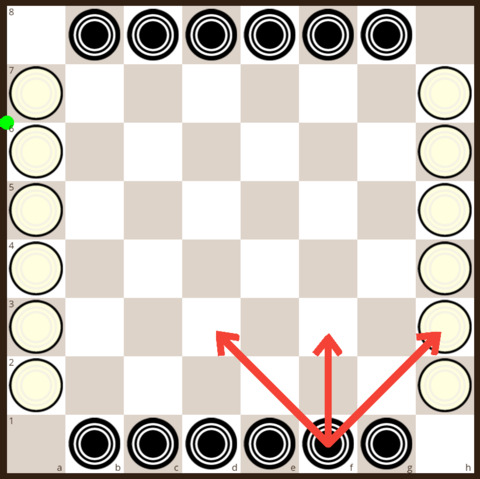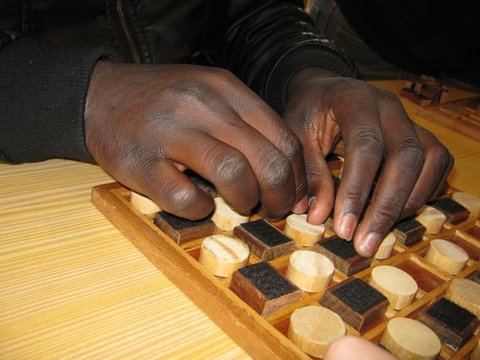by John Foley & Stefan Löffler
If you teach chess for educational motives, you should know about simpler games on the chessboard and how to introduce them to your students.

At Lines of Action, a piece moves in any direction by exactly as many squares as there are pieces on this file, rank or diagonal. You can capture enemy pieces. You can jump over your own but never over enemy pieces. The first player to connect all pieces on adjacent squares wins. (Created with LogiQBoard.com)
No other strategy game is taught in schools as much as chess or comes even close. From a pedagogical point of view, however, its complexity is a problem. Not only the rules of chess are taught but also strategies, tactical motives and guidelines for play. Learners hardly get the opportunity to discover for themselves. In simpler games than chess, children find out for themselves, through trial and error, which strategies lead to success. They detect tactics that work out. As they play more often, they make fewer and fewer moves that don’t get them anywhere. Simple strategy games are also suitable for pre-school children.
But such games that enable children to make learning progress on their own rather than under guidance are hardly known. Traditional games like Checkers or Nine Men’s Morris are far less suitable than inventions of the last decades like Breakthrough, Cats & Dogs, Domineering or Lines of Action. The mentioned games and many more can be played on 8 by 8 squares just like chess.
In simpler games than chess, children find out for themselves, through trial and error, which strategies lead to success, and they detect tactics that work out.
The only country where simple strategy games are systematically used in schools is Portugal. A professional society for mathematics, the Associação Ludus, teaches the games to educators and supports them in organising tournaments. Learning a diversity of games and making their own choices which to play goes down especially well with girls. Ludus has also developed special boards for blind and visually impaired students.

Konane, a Hawaiian game, is played by a blind student on a haptic board. (photo: Ludus)
Three maxims guide Ludus in the selection: Every game must be so simple that the rules can be learned in a minute. It must not become boring even after a few dozen games. And it should be rare or even impossible that a game ends in a draw. The most traditional game that Ludus has been teaching is Go on a smaller board with 9 by 9 intersections instead of 19 by 19. Go pieces are only set but never moved. Games without moving have the advantage that they can also be played with pencils and paper instead of a board and pieces. This opens more pathways between games and mathematics. Once children have pencil and paper, it is easier for them to analyse and understand the geometric and logical motifs of a game.
Ludus joined forces with the House of Mathematics of the Pedagogical University of Vienna and the chess education company ChessPlus that has developed different teacher trainings, connecting chess with mathematics and with logic. In the project 8×8, funded by Erasmus +, teaching materials are developed and a qualitative study on the apprehension of an abstract game in the primary school classroom has been conducted. In two webinars organised by ChessTech you can learn some of these games, why and how to teach them, and get to know the LogiQBoard software that was used to create the graphics next to this article. You will be among the first to see the 8×8 teacher manual.
As the name indicates, the 8×8 project has focused on games that can be played on the chess board. A good example is Breakthrough, invented by the American Dan Troyka and winner of a prize for the best new game on eight by eight squares in 2001. Each player has sixteen equal pieces that move similarly like pawns. The first to bring a pawn to the opposite back rank wins. To play well requires planning, calculation and the ability to spot weak squares. As you may guess by now, kids that already know chess are especially good at Breakthrough. Try it out here.

Breakthrough is simple: A piece moves one square at a time ahead straight or diagonally, never backward or sideward. Captures are diagonally ahead but not obligatory. The first player to reach the opposite back rank wins. (Created with LogiQBoard.com)
If you want to learn more join our free events:
02 December 2021
17:00 – 18:30 London Time
18:00 – 19:30 Central European Time
13 December 2021
17:00 – 18:30 London Time
18:00 – 19:30 Central European Time
